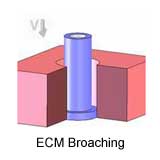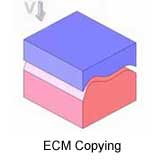Electrochemical machining (ECM) is a method of creating metal shapes by removing metal using an electrochemical process. A direct current with high density and low voltage is passed between a workpiece (the anode) and a pre-shaped tool (the cathode). At the anodic workpiece surface, metal is dissolved and thus the tool shape is copied into the workpiece.
Electrochemical machining creates components that are not subject to either thermal or mechanical stress and brittle material can be machined easily as there is no contact between the tool and workpiece. Electrochemical machining can create normal and delicate 3D shapes. Some example of parts that are made using electrochemical machining include dies, molds, turbine and compressor blades, cavities, holes, slots, etc. Electrochemical machining can process most types of conducting materials and alloys. Custom tooling is required in the negative of the desired part shape.
Various industrial techniques have been developed on the basis of of the process including:
- Electrochemical cutting
- Electrochemical ECM
- Electrochemical broaching
- Electrochemical drilling
- Electrochemical deburring
 |  |




No comments:
Post a Comment